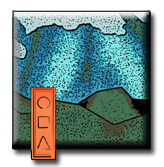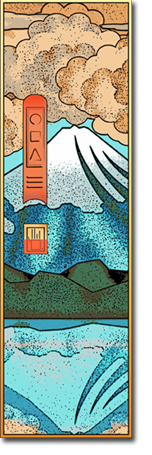On The Way: The Daily Zen Journal
Hakuin’s Song of Meditation
Hakuin (1685-1768)
Commentary: Abbot Amakuki Sessan 1930
All beings are from the very beginning Buddhas
It is like water and ice:
Apart from water, no ice,
Outside living beings, no Buddhas.
Hakuin (1685-1768)

In the original, the Song of Meditation is written in very easy language. Before Hakuin, Zen in Japan had not quite given up its Chinese flavor, but with him it became completely Japanese. Previously, too, it had a somewhat aristocratic outlook, but he popularized it and made it universal.
If Muso Kokushi (1276-1351) of Tenryuji Temple, the teacher of emperors, represents aristocratic Zen, we may see Hakuin as the representative of the people’s Zen. His Zen is austere and yet universal, like towering Mount Fuji, to which everyone can look up from wherever they are.
Hakuin’s Zen is an eternal luminary in the spiritual firmament and a supreme contribution to Japanese culture. Though the Song is also easy to follow, it contains Hakuin’s profoundest and most mystical doctrine.
Of course, as to attaining his First Principle, which speech and thought cannot reach, each person has to realize that for themselves. If words or thought could grasp it, then it would be only a second or third principle. In these lectures the Song will be explained as far as possible in a simple and popular way which can be understood by anyone who cares to read it.
“All beings are from the very beginning Buddhas.”

“All beings” is a classical Buddhist phrase, but we can take it as referring principally to us human beings. This one phrase…is the center and beginning and end of the whole Song. We live in this world of illusion, and the Buddhas who live in the world of realization, are from the very beginning one and not two.
Illusion and realization are not two! The oneness of Buddhas and all beings is here proclaimed outright. If we can grasp this phrase completely, the rest of the Song will be easy. It is the center and beginning and end not only of the Song of Meditation, but the forty-nine years’ preaching of Shakyamuni Buddha was in essence the same truth, and the 84,000 gates of the Law are none other than this.
All beings are from the very beginning Buddhas. Buddha means an awakened person, an enlightened person. The word carries the meaning of deliverance from all bonds and fetters and ties. He awakens himself, then awakens others; that is to say, he is perfect both in realization and in spiritual action. He has realization, action, and perfection.
The Buddha has three bodies, first the body of truth such as Vairochana Buddha, the Buddha of Truth, whose form is all-pervading; his tongue, the stream in the valley; his pure body the colors of the mountains—the wind and the light, the hills, rivers, grass, and trees, all are this truth-body of the Buddha.
The second is the body of bliss; by virtue of holy practices the ideal Buddha like Amitabha appears in an ideal form. The third is the body of physical manifestation, which is the Buddha who appears as a man, the so-called historical Buddha, a Buddha like Shakyamuni, who appeared in India. These three bodies, the truth-body, the bliss-body, and manifesting body, express the three aspects of the Buddha-essence, form, and action.
But this Buddha and ourselves are not separate. All beings are from the very beginning Buddhas. It is the same truth as in the famous phrases that the passions are bodhi, that Samsara or birth-and-death is Nirvana.
Being in the world of illusion is called “living being,” and being in the world of realization is called “Buddha.” When deluded, a living being: when enlightened, a “Buddha.” The Buddhas are the living beings, ignorance is enlightenment, enlightenment is ignorance, so the Buddhas and living beings are the same.
It is related in the Avatamsaka Sutra that after six years of intense practice, on the eighth day of the twelfth month under the bodhi tree, Shakyamuni saw the morning star and suddenly had the great realization (satori).
His first utterance was: “Wonder, wonder! All living beings are endowed with the Buddha wisdom and virtue!” Another account says it was in these words: “When a Buddha attains and sees the truth-world, grasses, trees, earth—all, all become Buddhas!”
In other words the Buddha nature is perfect in each and every one of us. The Prajnaparamita Sutra says that form is the void and the void is form. The relationship between the Buddhas and living beings is exactly like that. The Sutra does not say that the world of forms, the material things are annihilated and then the void is attained, or that out of the void, as reality, the world of forms is manifested. The world of forms as it is now is the void, and similarly the void without changing manifests the form-world of mountains, rivers and earth.
The successive Buddhas and lines of patriarchs have taught in various ways the oneness of Buddhas and living beings and have given different illustrations, but Hakuin thunders directly at us: “All living beings are from the very beginning Buddhas!”
This is the characteristic living method of his Zen. There is no holding back; it is a true lion’s roar. We are always thinking of getting away from this shore of illusion and attaining some far shore of realization, of getting out of the state of the ordinary person and reaching the world of the Buddhas; we take illusion and satori as opposites and the ordinary person and the Buddha as quite separate, different as fire and water.
We wander desperately about where the road forks, one path “to illusion” and the other “to satori.” Now Hakuin fearlessly shouts that all living beings are from the very beginning Buddhas. His great cry proclaims tersely and clearly the sense of the passage in the Sutra of Perfect Wisdom:
“When we come to know that all living beings are from the very beginning Buddhas, then Samsara and Nirvana both are like last night’s dream.” Nothing stands between living beings and Buddhas, between illusion and realization.
The point is skillfully made in Hakuin’s next phrase, “It is like water and ice: apart from water no ice, outside living beings no Buddhas.” To show the absolute oneness of ordinary people and Buddhas, he adduces ice, which is fundamentally water. Apart from water there can be no ice; that very piece of ice is just the water, and the water is just the ice. But the ice comes from the water. Daito Kokushi has a verse on this:
“Search in the water and you will not find the waves,
Yet the waves arise from the water.”
The word “ice” is significant. Water, when exposed to cold, freezes, hardens, and becomes ice, and though its nature does not change, it loses complete freedom of movement. So through the illusion of ignorance, the human being sets and hardens, and although his Buddha-nature does not change, he is debarred from the limitless freedom of the Buddha. But just as the ice, set and hardened by the cold, is still in fact all water, so the human being, set and hardened by illusion, is still in fact all Buddha.
Abbot Amakuki Sessan commenting on Hakuin’s Song of Meditation
Taken from a series of lectures over the Kyoto Radio early in the 1930’s, and soon afterwards revised for publication.





Yes, while it is true that the Song of Meditation uses language that is easy to understand, the concepts can seem so contradictory to our experience of everyday life that it can feel too theoretical and esoteric.
Thankfully, the illustration using water and ice works well to give us a sense of the ultimate freedom of non attachment versus the entrapment that the senses draw us into. Water is flowing and changing with the vessel or environment; once our sense of self has hardened like ice, the rigidity keeps us from seeing and experiencing with flow.
It is also a huge jump from the first teaching of the Four Noble Truths the Buddha taught after his enlightenment to the interpenetration of daily life and enlightenment. And living in extreme times as we do now, it is difficult to see with universal vision. It is like we bounce from feeling a kind of oneness and flow to having to consider what “right action” consists of in the here and now.
However, if we embrace the fact that “all beings are from the very beginning Buddhas” and just allow that to wash over and into us without allowing the mind to start up its chattering, the seed that is planted can be nourished with meditation and faith in the Way which allows a new way of being to develop.
Faithfully yours,
Elana, Scribe for Daily Zen